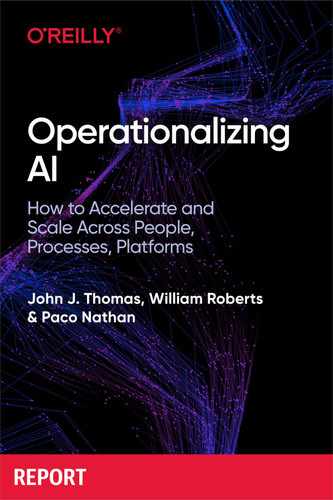Preface
Increasingly, data scientists are consulted on a daily basis about making sustained and fundamental changes to the ways their organizations do business. However, their organizations are typically not designed to realize the benefits of those changes. Company leaders rely on these highly skilled and expensive data scientists to help them change their respective markets by building predictive capabilities into their products and workflows, but they often think the change can be led by the data science team alone. Across industry sectors, management and leaders see a gap between the promised and actual impact of data science projects, and wonder why there is such a noticeable difference.
At the heart of this gap is delay. The longer the time to market for data products, the higher their cost and the greater their risk. The risk increases as data drifts, scope creeps, and requirements grow. To shorten the time to market, lower overhead, and reduce the risk, organizations need a comprehensive understanding of how to build artificial intelligence in a repeatable fashion. In other words, organizations need to understand how to operationalize AI.
Operationalizing AI, which we will define more fully in the next sections, allows disparate technology groups with shared deliverables to adopt a unified language around how they talk about data science within the business. To demonstrate the value of operationalizing AI, let’s consider how software development has evolved. Delivering software applications is now table stakes. To be a market leader in any industry, your organization must understand, define, and standardize that delivery process; otherwise, it would be outpaced by its competitors. Application development is clearly defined so that developers and DevOps teams understand how to transition onus between each other, and that understanding is reflected in their daily habits. Originally, this was not the case with development (DEV) teams and quality assurance (QA) teams.
Prior to the modern dogma of DevOps, DEV and QA teams would throw their work “over the wall” to the next team that was responsible for pushing their code to production systems. Those operations groups and development teams weren’t measured against similar goals, and collaboration was flawed. The result was finger-pointing when mistakes inevitably occurred and inconsistent processes that left all parties wanting. By implementing a DevOps practice and culture, companies try to lower their deployment failure rates, increase their deployment frequencies, and limit production failures. Test suites, virtual infrastructure, and build servers are all stack choices that facilitate deployment processes and make DevOps work consistent. Many of the hangups that DevOps has addressed are consistent with the problems that data science teams and engineering teams face today in handing off work between each other. This challenge is further compounded as other teams also need to collaborate for successful AI solutions. How do we establish a new modern dogma for operationalizing AI in a similar context, where parties with differing success criteria can collaborate to ultimately produce software that includes critical artificial intelligence capabilities?
We know this space between the reality and expectations of AI can be filled once an organization is prepared to review and reorganize itself, with the goal of building better predictive data products. We’re writing this report to enable organizations to adopt artificial intelligence into their businesses, aid their business users, and build mature data products. Data scientists will learn how the technology and organization must work together, hand in hand, to support the organization’s mission. Leaders of data science teams will learn how their organizations can transparently and seamlessly facilitate the delivery of data products. Business leaders will learn the business value, both realized and potential, of introducing data science expertise in their organizations.
This report will distill and reveal essential themes from the conversations we’ve had with data science teams across industries, with the goal of building a shared language about the practice of developing artificial intelligence solutions. In the spirit of building a shared language, we’ll define several key terms along the way. Unifying language and intention is an inherent part of any interdisciplinary practice, and the work between engineering groups and data scientists is no different. We’ll begin the report by looking at the current view of artificial intelligence adoption for businesses, talk about organizational best practices, and present case studies from leaders in the field. By the end of this report, you will understand how to operationalize artificial intelligence across teams in your organization.
Acknowledgments
Thank you to these individuals for collaborating with us:
- Kristen Summers, Distinguished Engineer, Cloud and Cognitive Expert Labs, IBM
- Susara van den Heever, Director, C&CS Expert Labs, IBM
- Sheetal Rishi, Director, Cloud and AI, IBM
- Alexander Pavelka, Head of Data and Analytics, Red Bull
- Manuel Neumann, Global Head of Data Science, Red Bull
- Dries Trippas, Senior Data Scientist, Red Bull
- Jacques van Niekerk, CEO, Wunderman Thompson Data
- Michael Murray, Chief Product Officer, Wunderman Thompson Data
